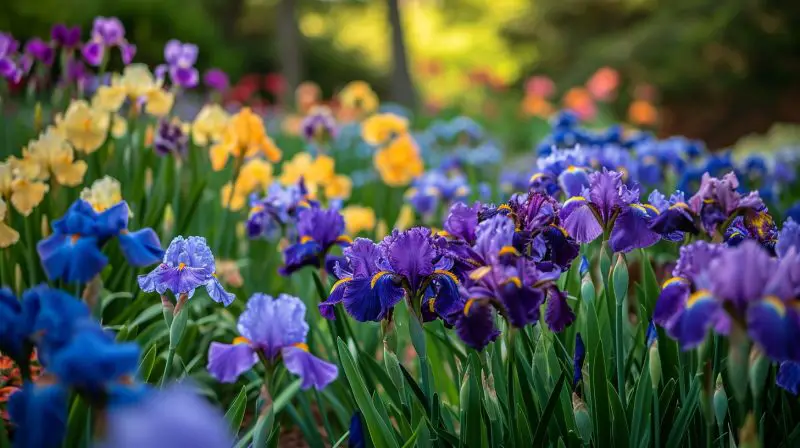Irises are among the most captivating perennials, celebrated for their vivid colors, sword-like foliage, and intricate floral structure. These low-maintenance plants thrive in various climates and can bring perennial charm to gardens for decades—provided they are properly cared for. One of the most essential maintenance tasks for healthy, long-lasting iris plants is division. Over time, iris clumps become overcrowded, diminishing bloom quality and vigor. Learning how to divide and replant irises correctly ensures their beauty flourishes year after year.
This comprehensive guide explores the best techniques and timing for dividing irises, how to prepare your garden for replanting, and how to nurture them for maximum flowering potential. Whether you’re working with bearded, Siberian, or Japanese irises, these practices will help keep your garden radiant.
Why Dividing Irises Is Essential for Longevity

Over the years, iris rhizomes—the horizontal, underground stems that store energy—tend to multiply and form dense clumps. While this may initially appear healthy, these crowded conditions actually restrict the plants’ ability to absorb nutrients, leading to fewer blooms and increased susceptibility to disease. Irises that once put on a brilliant display may begin to show signs of stress, such as reduced flowering, yellowing leaves, or empty centers in the clump.
Dividing irises rejuvenates the plant by removing older, non-productive rhizomes and encouraging the development of new, vigorous growth. This process also gives gardeners the chance to inspect for rot, pests, or signs of fungal infection that might otherwise go unnoticed. Moreover, dividing irises is a cost-effective way to multiply your plants without purchasing more, making it a practical and rewarding task.
Properly timed division every three to five years helps irises maintain a robust root system, reduces competition for water and nutrients, and ensures continuous, vibrant blooming season after season. Without this critical care step, even the hardiest varieties will eventually falter.
When to Divide Irises for the Best Results
Timing is crucial when it comes to dividing irises. The ideal period is in late summer to early fall, approximately six to eight weeks after the plants have finished blooming. This window allows the plants to recover from the stress of division and reestablish their roots before winter sets in. For many gardeners, this means July through September, depending on local climate conditions.
During this post-bloom phase, the energy from the fading foliage is redirected to the rhizomes, giving them the strength needed to generate new roots after division. Attempting to divide irises while they are still actively blooming or growing can hinder their recovery and stunt their future performance. Dividing in early spring is not recommended unless absolutely necessary, as the plants are just waking up from dormancy and may not have sufficient energy reserves.
Cooler temperatures, reduced insect activity, and minimal competition from aggressive weeds make late summer the perfect time to handle and transplant irises. Planning your division during this seasonal window maximizes your chances of successful replanting and thriving blooms the following year.
Preparing the Iris Clump for Division
Before you begin dividing your irises, it’s important to properly prepare the existing clump. Begin by watering the iris bed thoroughly a day or two in advance. This softens the soil and makes lifting the clump easier, reducing the chance of damaging the rhizomes or root system. Once the ground is moist and workable, use a garden fork or spade to gently lift the entire iris clump from the soil, starting from the outer edge and working inward.
Take care to avoid slicing through rhizomes during this process. Once the clump is lifted, shake or wash off the soil so you can see the full network of roots and stems. Healthy rhizomes should feel firm and solid, with visible leaf fans attached at one end. Avoid tugging or pulling them apart roughly, as this can lead to accidental damage or missed pests and diseases.
Inspect the entire clump thoroughly. Discard any sections that are soft, mushy, discolored, or have a foul odor, as these could indicate rot or bacterial infection. Keeping only healthy, vibrant sections ensures your new plantings will establish strong, disease-free foundations for the coming seasons.
How to Divide Iris Rhizomes Effectively
With the clump exposed and cleaned, the next step is dividing the rhizomes into manageable and viable pieces. Use a sterile, sharp knife or garden shears to cut apart the rhizome into sections, making sure each division contains one or two healthy leaf fans and a firm portion of root. Avoid including more than three fans per piece, as overly large sections can struggle to adapt after transplanting.
When separating the rhizomes, trim the foliage down to about one-third of its original height. This reduces water loss and allows the plant to focus its energy on root development rather than sustaining long leaves. Keep an eye out for signs of iris borers or fungal growth; any affected sections should be destroyed immediately to prevent the spread of disease.
It’s also a good idea to let the cut rhizome pieces cure for a few hours in a shaded, well-ventilated area. This short drying period helps the cuts heal and reduces the risk of rot when replanted. While optional, curing can significantly improve the overall health and longevity of your transplants.
Choosing the Right Planting Location for Irises
Selecting a suitable site is just as important as the division process itself. Irises thrive in well-drained soil and full sunlight, needing at least six hours of direct light daily to produce their signature blooms. A location with good air circulation also helps prevent moisture-related diseases like leaf spot and root rot.
Avoid areas with heavy clay soil or poor drainage, as stagnant water can cause the rhizomes to rot. If your native soil retains too much moisture, consider amending it with sand or compost to improve texture and drainage. Raised beds or slopes can also offer ideal environments for iris cultivation by promoting excess water runoff.
Before planting, remove weeds, rocks, and debris from the chosen site. Loosen the soil to a depth of about 8 to 10 inches, working in organic matter such as compost or aged manure to enrich the bed. This provides a nutrient-rich base that will support root establishment and promote lush, healthy growth.
Replanting Irises for Long-Term Success
Once the site is ready and the rhizomes are cured, begin planting by creating shallow trenches or mounds. Position each rhizome horizontally with the roots facing downward and the top of the rhizome just barely covered or exposed. Irises do not like to be planted too deeply; burying the rhizomes entirely can lead to rot and inhibit flowering.
Space the divisions 12 to 18 inches apart to allow for future growth and air circulation. After placing the rhizomes, gently firm the soil around them and water thoroughly to help settle the roots. It’s normal for the foliage to look wilted or tired after transplanting, but this will improve as the roots take hold.
During the first few weeks, keep the area slightly moist but not soggy. Once the plants are established, they will require less frequent watering. Avoid mulching directly over the rhizomes, as this can trap moisture and encourage disease. If mulching is necessary, keep it light and positioned around—not on top of—the plants.
Post-Planting Care to Ensure Healthy Growth
After replanting your iris divisions, the focus should shift to nurturing their establishment and promoting healthy development. Watering is key during the initial weeks, especially during dry spells. However, overwatering must be avoided, as excess moisture can cause newly planted rhizomes to decay before they root properly.
Feeding your irises with a balanced, low-nitrogen fertilizer about a month after planting can support early root development. Too much nitrogen encourages leafy growth at the expense of blooms, so opt for a fertilizer labeled for bulbs or flowering perennials. Apply sparingly, and water the area lightly after feeding.
Monitor the planting site for signs of pest activity, particularly from iris borers, which tunnel into rhizomes and cause significant damage. Keeping the area free of plant debris and cutting back foliage after the first frost can help prevent overwintering pests. Regular weeding is also important, as irises dislike competition from aggressive neighboring plants.
Understanding Iris Bloom Cycles After Division
Dividing and replanting irises may temporarily disrupt their bloom cycle. In some cases, newly planted divisions may not flower during the first season after replanting, especially if divided late or in unfavorable conditions. This is normal and should not be a cause for concern.
As the roots become established and the plant acclimates to its new environment, it will resume its natural bloom cycle. In fact, proper division is often the key to restoring bloom performance in older clumps that had stopped flowering altogether. By the second or third year after division, irises typically return to full bloom capacity with greater vigor.
Tracking bloom times across seasons can help you assess whether your care methods are effective. Keeping a garden journal to document bloom size, timing, and health can guide future divisions and fertilizing schedules. A little observation goes a long way in maintaining a thriving iris bed.
Multiplying Your Garden With Divided Irises
One of the most satisfying rewards of dividing irises is the ability to multiply your garden stock. Each healthy division can be planted in a new location, shared with friends, or used to create a mass planting for a dramatic visual impact. Over time, a single iris plant can produce dozens of offspring, making it a perennial favorite for gardeners who appreciate both beauty and practicality.
Strategically placing your divided irises in different parts of your yard can extend the flowering season, attract pollinators, and create cohesion in your landscape design. Different varieties can be paired to produce contrasting or complementary colors, giving your garden a custom look.
As your collection grows, you can experiment with layout, spacing, and elevation to create layered visual interest. Irises are especially effective in borders, slopes, and raised beds where their foliage and flowers can stand out. With thoughtful planning, divided irises can form the foundation of a truly breathtaking garden.
Troubleshooting Common Iris Division Problems
Even with the best techniques, issues can arise during or after the division process. If your irises fail to establish or show signs of rot, consider whether the rhizomes were planted too deeply, overwatered, or placed in poorly draining soil. Adjusting these conditions can often resolve the problem quickly.
Fungal diseases such as soft rot or leaf spot may occur when rhizomes are kept too wet or lack sufficient airflow. Improving drainage, spacing, and sun exposure can help mitigate these problems. If pests like iris borers are discovered during division, discard any infested rhizomes and treat the soil with an appropriate insecticide before replanting.
Yellowing or drooping leaves after division are typically signs of transplant shock. Give the plants time to adjust, maintain light moisture levels, and avoid fertilizing until new growth appears. Patience and attention to site conditions are key to troubleshooting successfully.
FAQ about How to Divide and Plant Irises
How often should I divide my irises?
Irises should generally be divided every three to five years. If you notice decreased blooming, crowded rhizomes, or an empty center in the clump, it’s time to divide.
Can I divide irises in spring?
While it’s possible, dividing in spring is not ideal. Late summer to early fall is the preferred window because the plants are dormant and better able to handle the stress of division.
Should iris rhizomes be buried completely?
No, iris rhizomes should be planted just below or at the surface level. Burying them too deeply can lead to rot and poor blooming performance.
Why aren’t my newly planted irises blooming?
It’s common for irises not to bloom the first year after division. The plant is focusing on root development. Expect full blooms by the second season if properly cared for.
Conclusion
Dividing and planting irises is a simple yet powerful way to keep your garden vibrant and blooming year after year. By understanding the right timing, proper techniques, and post-planting care, you give your irises the best chance to thrive. With just a bit of seasonal attention, these stunning perennials will reward you with healthy growth and dazzling displays for seasons to come.






